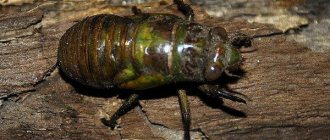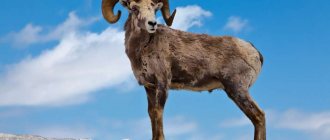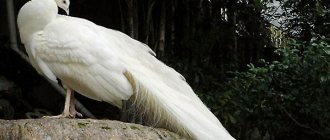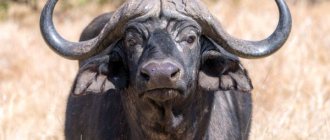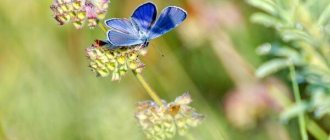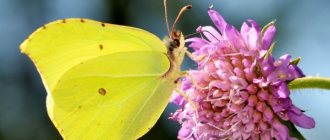The mountain sheep also has other names, such as argali, argali, kachkar, arkar. This is a very graceful animal that lives in the wild. This animal represents the bovid family. Found in the highlands of Central Asia. The mountain sheep is the largest animal of its kind. Despite the fact that experts are still arguing about how many species of sheep there are on our Planet, most of them have identified 7 species. The term “Mountain sheep” is used by some in relation to many species, while others only in relation to argali.
Appearance description
Argali mountain sheep are the largest among all varieties of this genus. In the scientific classification, the name of the species sounds like Ovis ammon. The second part comes from the name of the Egyptian god Ammon, who, according to legends on the eastern side of the world, turned into a ram. He was often depicted with long curly horns.
These are beautiful animals with a proud posture, slender body and long legs. Because of their impressive horns, their heads are thrown back. Here are the main parameters of the appearance and description:
- The length of the body in males is 1.7-2 m, in females - 1.2-1.5 m.
- The height of the ram is 106-125 cm, the height of the sheep is 95-112 cm.
- Males weigh 110-170 kg (in exceptional cases - about 200 kg), females weigh 60-100 kg.
- The base of the skull in males is 25-35 cm, in females it is 23-30 cm.
- The head is large, massive, with a straight or slightly hook-nosed profile; in females the head is more even.
- The muzzle is pointed (in females it is narrowed), with white fur and light nostrils.
- The ears are very mobile, with tassels at the tips.
- The horns of males are long, twisted into a ring or spiral, the tips are curved upward, the length can reach 2 m, their weight together with the skull can reach 40-50 kg, accounting for up to 13% of the total body weight.
- The females have small horns, from 5 cm to 60 cm, slightly bent back and crescent-shaped, like those of goats; polled sheep are sometimes found.
- The neck is relatively short and massive.
- The breast is wide and well developed, with a girth of 120-135 cm.
- The body in general body proportions looks slender and slightly shortened.
- The metacarpal and metatarsal bones on the legs of argali are elongated; neither the mountain goat nor the bighorn sheep have this structure; this allows the argali to quickly run across the plain and deftly climb steep slopes.
- The hooves in front are 4-4.5 cm long, in the back they are 2-4 mm shorter.
- There are 2 additional hooves on the back of the legs.
- The tail is straight, up to 18 cm long.
The coat color of Argali ranges from sandy yellow (almost white) to brown-brown; in winter the fur darkens. In the lumbar region of rams there is a white spot; the belly, the inner surface of the forearms and thighs, and the muzzle are painted in the same color. On the nape of the males, the hair is longer and colored in a lighter tone. The mountain sheep and the goat are somewhat similar, but the Argali does not have a beard, its horns are larger and more tightly curled. Sheep, unlike goats, do not have scent glands that impart a specific smell to their wool.
Range and habitat
The mountain sheep of the Argali or Argali variety lives in some areas of Central and Central Asia, Mongolia, Kazakhstan in the east and west of Siberia. Included in the range of the Tien Shan range, Palmyra, Sayan. There are Argali in the foothills of Nepal, the Himalayas, Tibet, and some areas of Dagestan. Now it covers an area of about 10,000 km²; it used to be much larger and covered almost the entire Asian region.
The herds live at an altitude of 1300-1600 m, preferring plateaus and gentle slopes. Although animals can often be seen on the rocks, especially where domestic animals are crowding them out of more fertile and level areas. Individuals prefer open spaces; in winter and early spring they migrate to valleys, and in the summer they climb high into the mountains, to the border of alpine meadows and eternal snow. Horizontal migration is weakly expressed and occurs within a range of 30-40 km².
- 35 facts about foxes
- Animals of Brazil
- Tarantula spider
- 34 facts about lions
- Lynx
- 37 facts about cheetahs
The Argali flock consists of 30-100 individuals, the largest herds now live in Mongolia. During the period between the ruts, males and females with cubs stay separately. Sheep form quite large herds and violently drive the rams away from them. Males live in bachelor groups of 6-10 animals.
The highland sheep feeds on almost all plants that can be found on the sparse mountain slopes. In summer, animals rise to the area of alpine meadows, where they find lush grass rich in fiber. In winter, if the snow layer exceeds 10 cm, they descend into the valleys. From under the snow, sheep get last year's dry grass, moss, and lichens. The large animal requires a lot of plant food; it eats about 18 kg of food per day. With a lack of food in winter, many weak individuals die.
Argali live in constant motion, moving from pasture to pasture in search of better food. They are very agile and run well on rocky mountain slopes. They can jump over gorges up to 5 m wide and climb rocks. They run on the plain at a speed of 50-60 km/h.
The animals are timid, and at the slightest alarm they move and run away. Natural enemies of Argali are wolves, lynxes, wolverines and snow leopards. They do not significantly affect the population size, since they destroy only weak animals. People cause much more harm to Argali.
Features of behavior
Wild sheep lead a sedentary lifestyle, forming herds where they display a tolerant and friendly disposition. In cases of danger, alarm signals are given: for adults this is a snort, for young animals it is bleating. After which the herd is sent to a safe place, inaccessible to predators.
These animals climb mountains well, they can jump to a height of up to 2 m and a length of up to 5 m. The peak activity of rams occurs in the first half of the day. They graze mainly in the morning and evening.
Reproduction
The rutting period for Argali mountain sheep begins in October or November. At this time, rams and lambs form common groups. The laws of polyandry and polygyny apply in them; several females and males participate in mating at once. Sheep reach sexual maturity already at 2-3 years, rams only at 4-5 years, males take part in reproduction after 5 years. Before mating, the rams have fights so that the females choose the strongest one.
The female's pregnancy lasts 150-160 days, which is 40-50 days longer than that of a domestic sheep. Lambs are born in the spring when food supply increases. Before giving birth, the female retires to a secluded place. The process lasts 20-30 minutes, a newborn lamb weighs 3-4 kg.
Most Argali give birth to one baby at a time; twins are extremely rare. The little lamb almost immediately stands on its legs and attaches itself to the nipple. The ewe lives alone with her lamb for about a week, then joins the flock.
The lambs in the herd stay close together and constantly play with each other. From the second week, their horns begin to grow, and from a month on, the pets are already eating grass. They feed on milk for up to 4-5 months; the female cares for her offspring for the same amount of time. From 5 months, lambs become completely independent. Harsh living conditions allow only 50-55% of the young to survive, because of this the Argali population cannot grow quickly. The total lifespan of Argali mountain sheep in the wild reaches 10-13 years, but many individuals do not live up to 6 years. In zoos this species can live for 18 years.
Subspecies of Argali
Subspecies or species of Argali mountain sheep live in different regions. They differ in size, coat color, and some features of standing and behavior.
Altai mountain sheep (Ovis ammon ammon)
Anatolian mouflon (Ovis ammon anatolica)
Bukhara mountain sheep (Ovis ammon bosharensis)
Kazakhstan argali (Ovis ammon collium)
Tibetan mountain sheep (Ovis ammon hоdgсonii)
Tien Shan mountain sheep (Ovis ammon karelini)
Argali Kozlova (Ovis ammon kozlovi)
Cyprus mountain sheep (Ovis ammon orhion)
Marco Polo mountain sheep (Ovis ammon rolii)
Kyzylkum mountain sheep (Ovis ammon severtzоvi)
Modern zoological taxonomy and classification does not classify all subspecies as Argali. For example, Kyzylkum sheep are now bred as a separate variety. Argali's closest relatives are Mouflon and Ureal, which live in approximately the same regions, but their habitat is wider.
Male and female mountain sheep: main differences
Sexual dimorphism in mountain sheep is manifested in the fact that the horns of males are more powerful and larger. In addition, males have a noticeable ring of light hair on the neck, and longer hair on the nape.
Diet
These mammals feed on plant foods, preferring cereals. They can eat lichens, branches of bushes and trees, namely:
- oak;
- maple-pistachio;
- hornbeam;
- caragan
Mountain sheep regularly go to watering places and lick salt in the sun. During the winter cold, a layer of subcutaneous fat accumulates.
Problems of species conservation
The wild mountain sheep Argali and all its subspecies are very few in number, some are threatened with complete extinction, which is why they are listed in the Red Book of many countries, including Russia, Kazakhstan, Mongolia, and China. Not only hunting of animals is prohibited, but also the sale of skins, horns and other parts of the carcass. Despite all protective measures, the number of animals is constantly declining. The Dagestan population has practically disappeared, the plight of the Argali from the Kyzylkum desert.
Huge massive horns of argali are the main trophy of poachers. Their price on black can reach 10 thousand US dollars. No matter how much the authorities fight against the illegal sale of horns, the underground trade is quite intense. Shooting is carried out even in strictly protected areas, especially in Russia, Kazakhstan, Mongolia, and Central Asian countries. In addition, this organ is often used in Chinese medicine, which threatens the existence of the Tibetan and Palmyra varieties.
In addition, the existence of the livestock is threatened by human activity. The main risks are caused by:
- grazing flocks of domestic sheep;
- construction of various buildings and barriers on migration routes;
- construction of railways and highways in habitats;
- mining.
Intensive development of agriculture while maintaining free grazing of livestock has significantly undermined the population size in Mongolia. The disappearance of argali in Eastern Siberia is associated with mining in this region. Chinese animals suffer from intensive population growth, the construction of roads even to hard-to-reach areas, and the emergence of new settlements.
In order to preserve the mountain sheep and the species of this animal, protected areas are created where it is not only prohibited to hunt, but also to graze livestock and engage in mining. Catching animals is permitted only for the purpose of their further reproduction in captivity.
Argali take root well in zoos and produce healthy offspring. This gives hope that over time it will be possible to populate areas where herds have long disappeared with new individuals.
Interesting Facts
- Mountain sheep are the largest representatives of wild sheep. The Latin species name “ammon” goes back to the name of the god Amon. According to myths, due to their strong fear of Typhon, the celestials turned into various animals, and Amon turned into a ram. According to ancient tradition, this god was even depicted as a man with large and curled ram horns.
- It is for their horns that people have hunted mountain sheep since ancient times. Previously, in Chinese folk medicine, various potions were prepared from them. Now the price for the horns of this species reaches tens of thousands of dollars.
- Mountain sheep are often forced out of pastures by livestock, after which the fields are absolutely unsuitable for feeding these wild animals. The population size is negatively affected by climate change and very harsh and snowy winters. But in general, the status of the number of animals is difficult to track due to their mountain lifestyle.
- Mountain sheep are listed in the Red Book of Russia; hunting them is prohibited. These animals are very easy to tame; in captivity they are kept in spacious pens with high and strong fences, and in rooms with drinking bowls and feeders. To restore the species' numbers, endangered animals are placed in zoos and nature reserves.
Video
Natural enemies of the mountain sheep
Of the main enemies of argali, wolves occupy the first place in importance. This predator's hunting of bovid-horned artiodactyl mammals causes great damage to the population, since mountain sheep prefer to stay on the most flat and fairly open, as well as clearly visible places.
Also, the number of argali is significantly reduced due to such natural enemies of mountain sheep as snow leopard, leopard, coyote, cheetah, eagle and golden eagle. Among other things, mountain sheep are still very actively hunted by people who kill artiodactyl mammals in order to obtain meat, skins and expensive horns.
Return to content
